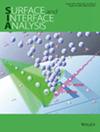利用二次离子质谱法量化钯合金中铂浓度的挑战:强烈的晶粒取向效应
IF 1.8
4区 化学
Q4 CHEMISTRY, PHYSICAL
引用次数: 0
摘要
采用动态二次离子质谱法(SIMS)分析了钯铂合金,以研究晶粒取向效应,这种效应使铂/钯计数率比相差高达 400%,即使在含 1 wt% 铂的钯样品小幅旋转时的同一晶粒内也是如此。晶粒取向由电子反向散射衍射(EBSD)确定。凹坑深度通过白光干涉仪(WLI)进行测量。SIMS环形山底部的扫描电子显微镜图像显示,在样品表面进行小幅旋转后,同一晶粒在某些旋转角度下通常会出现不同的微切面,这可能是低指数晶面的暴露。对观察到的晶粒取向效应仍缺乏全面的了解。不过,离子质量、溅射速率、离子导流、离子聚焦、优先溅射、表面高度、陨石坑微尖化和/或与角度有关的溅射等因素似乎都在起作用。对于这些钯铂合金,当试图通过 SIMS 量化浓度和获得深度剖面图时,强烈的晶粒取向效应又增加了复杂性。如果没有适当的取样和/或平均,在比较不同样品的结果时可能会得出非常错误的结论。本文章由计算机程序翻译,如有差异,请以英文原文为准。
Challenges in quantifying Pt concentrations in Pd alloys by using secondary ion mass spectrometry: Strong grain orientation effects
Palladium–platinum alloys were analysed by dynamic secondary ion mass spectrometry (SIMS) to investigate grain orientation effects that gave differences of up to 400% in the Pt/Pd count rate ratios, even within the same grain upon small rotations of a Pd sample with 1 wt% Pt. The sample had been homogenized by annealing, and the homogeneity was confirmed by X‐ray analysis in scanning electron microscopy (SEM). Grain orientations were determined by electron backscatter diffraction (EBSD). Crater depths were measured by white light interferometry (WLI). SEM images from the bottom of SIMS craters made in the same grain after small rotations around the sample surface normally showed different patterns of microfaceting for some rotation angles, probably exposing low‐index crystallographic planes. A complete understanding of the observed grain orientation effect is still lacking. However, factors such as ion mass, sputter rate, ion channelling, ion focusing, preferential sputtering, surface height, crater microfaceting and/or angle‐dependent sputtering seem to play a role. For these Pd–Pt alloys, the strong grain orientation effect adds another level of complexity when attempting to quantify concentrations and obtain depth profiles by SIMS. Without proper sampling and/or averaging, one could reach very wrong conclusions when comparing results from different samples.
求助全文
通过发布文献求助,成功后即可免费获取论文全文。
去求助
来源期刊

Surface and Interface Analysis
化学-物理化学
CiteScore
3.30
自引率
5.90%
发文量
130
审稿时长
4.4 months
期刊介绍:
Surface and Interface Analysis is devoted to the publication of papers dealing with the development and application of techniques for the characterization of surfaces, interfaces and thin films. Papers dealing with standardization and quantification are particularly welcome, and also those which deal with the application of these techniques to industrial problems. Papers dealing with the purely theoretical aspects of the technique will also be considered. Review articles will be published; prior consultation with one of the Editors is advised in these cases. Papers must clearly be of scientific value in the field and will be submitted to two independent referees. Contributions must be in English and must not have been published elsewhere, and authors must agree not to communicate the same material for publication to any other journal. Authors are invited to submit their papers for publication to John Watts (UK only), Jose Sanz (Rest of Europe), John T. Grant (all non-European countries, except Japan) or R. Shimizu (Japan only).
 求助内容:
求助内容: 应助结果提醒方式:
应助结果提醒方式:


